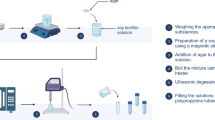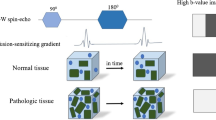Abstract
Object
Delta relaxation enhanced magnetic resonance (dreMR) is a new imaging technique based on the idea of cycling the magnetic field B 0 during an imaging sequence. The method determines the field dependency of the relaxation rate (relaxation dispersion dR 1/dB). This quantity is of particular interest in contrast agent imaging because the parameter can be used to determine contrast agent concentrations and increases the ability to localize the contrast agent.
Materials and methods
In this paper dreMR imaging was implemented on a clinical 1.5 T MR scanner combining conventional MR imaging with fast field-cycling. Two improvements to dreMR theory are presented describing the quantification of contrast agent concentrations from dreMR data and a correction for field-cycling with finite ramp times.
Results
Experiments demonstrate the use of the extended theory and show the measurement of contrast agent concentrations with the dreMR method. A second experiment performs localization of a contrast agent with a significant improvement in comparison to conventional imaging.
Conclusion
dreMR imaging has been extended by a method to quantify contrast agent concentrations and improved for field-cycling with finite ramp times. Robust localization of contrast agents using dreMR imaging has been performed in a sample where conventional imaging delivers inconclusive results.






Similar content being viewed by others
References
Alford JK, Rutt BK, Scholl TJ, Handler WB, Chronik BA (2009) Delta relaxation enhanced MR: improving activation-specificity of molecular probes through R1 dispersion imaging. Magn Reson Med 61(4):796–802
Alford JK, Farrar CT, Yang Y, Handler WB, Chronik BA, Scholl TJ, Madan G, Caravan P (2011) Direct albumin imaging in mouse tumour model. Proc Intl Soc Mag Reson Med 19:318
Alford JK, Sorensen AG, Benner T, Chronik BA, Handler WB, Scholl TJ, Madan G, Caravan P (2011) Direct protein imaging of inflammation in the human hand. Proc Intl Soc Mag Reson Med 19:452
Hoelscher U, Lother S, Fidler F, Blaimer M, Jakob P (2010) Unambiguous localization of contrast agents via B0-field-cycling. Proc Intl Soc Mag Reson Med 18:4939
Landis CS, Li X, Telang FW, Coderre JA, Micca PL, Rooney WD, Latour LL, Vetek G, Palyka I, Springer CS (2000) Determination of the mri contrast agent concentration time course in vivo following bolus injection: Effect of equilibrium transcytolemmal water exchange. Magn Reson Med 44(4):563–574
Lurie DJ, Aime S, Baroni S, Booth NA, Broche LM, Choi CH, Davies GR, Ismail S, O Hogain D, Pine KJ (2010) Fast field-cycling magnetic resonance imaging. C R Phys 11(2):136–148
Makowski MR, Wiethoff AJ, Jansen CH, Botnar RM (2009) Molecular imaging with targeted contrast agents. Top Magn Reson Imag 20(4):247–259
Negendank W, Corbett T, Crowley M, Kellogg C (1991) Evidence for a contribution of paramagnetic ions to water proton spin-lattice relaxation in normal and malignant mouse tissues. Magn Reson Med 18(2):280–293
Ungersma SE, Matter NI, Hardy JW, Venook RD, Macovski A, Conolly SM, Scott GC (2006) Magnetic resonance imaging with T1 dispersion contrast. Magn Reson Med 55(6):1362–1371
Acknowledgments
This work was performed with support from the Federal Ministry of Education and Research under Award No 01EZ0816, Siemens Healthcare Sector Erlangen and the Bavarian Ministry of Economic Affairs, Infrastructure, Transport and Technology. We thank Gunthard Lykowsky for his support with the RF birdcage coil and Philipp Kagerbauer for sample preparation.
Author information
Authors and Affiliations
Corresponding author
Rights and permissions
About this article
Cite this article
Hoelscher, U.C., Lother, S., Fidler, F. et al. Quantification and localization of contrast agents using delta relaxation enhanced magnetic resonance at 1.5 T. Magn Reson Mater Phy 25, 223–231 (2012). https://doi.org/10.1007/s10334-011-0291-6
Received:
Revised:
Accepted:
Published:
Issue Date:
DOI: https://doi.org/10.1007/s10334-011-0291-6




